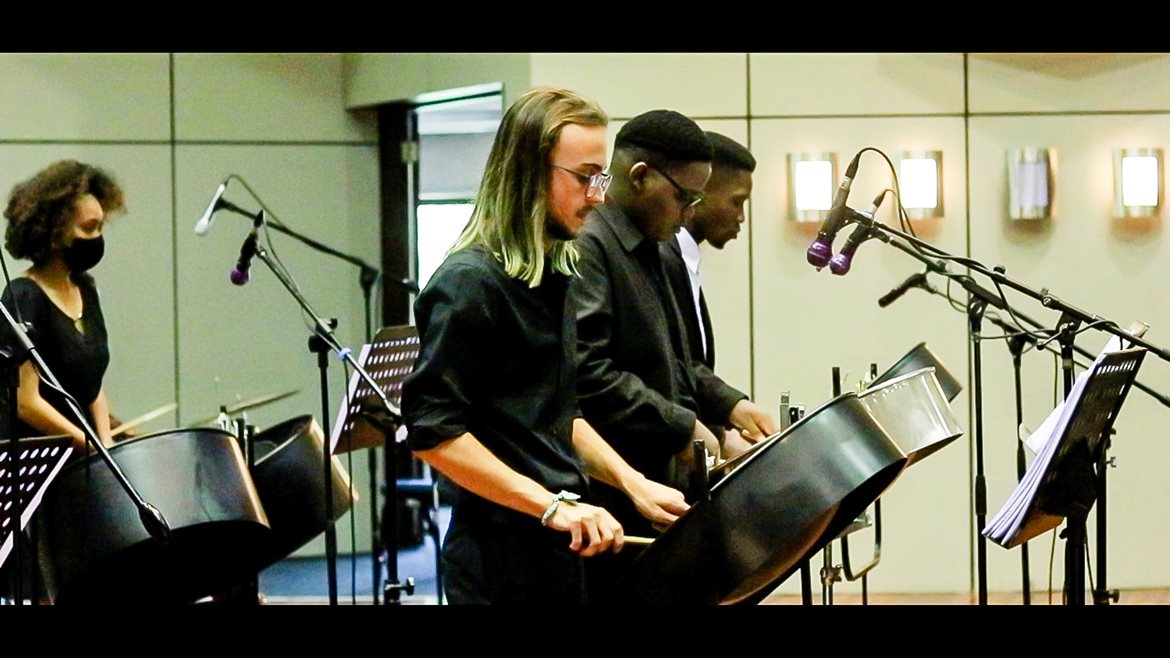The first steel pan main instrument student, second-year Siyamthanda Xotyeni, also came second in the 2019 SASMT South African Society of Music Teachers competition playing steel pan.
“Introducing steel pan as a main instrument was quite a major move away from the classical conservatoire. I wished to increase our music offerings and make the department accessible to more students, says Prof Alethea De Villiers, Music and Performing Arts Department Head at Nelson Mandela University.
Prof De Villiers met with the late David Santi from Lawson Brown High School and also David Parkin from Pans Inc, the manufacturer of steelpans and ordered steel pans and marimbas for teaching but as well as to make up a steel pan ensemble, who made this recording for Africa Day.
The second steel pan student is third-year Unathi Roqo who had to enroll for a diploma with drums as the main instrument, but who could now change courses to BMus with steel pan. Sylvester Appollis from Makhanda, teaches steel pan at Mandela University.
The University also has a marimba ensemble under the direction of Tendai Dembaremba who teaches marimba following African pedagogy.
Siyamthanda’s story
“Many people are fascinated by the bright and colourful sound-production of the steel pan and wonder how a steel object can emit such mesmerizing tunes? That is the furthest that the general majority go. Only a few are actually willing to dig deeper, says Siyamthanda.
Siyamthanda started playing steel pan when in Lawson Brown High School in Grade 8 and was immediately placed in the senior band. The late David Santi taught him throughout high school and into the early months of 2020 before he passed away.
“I can play all the steel pan instrument voices and have achieved many prestigious accomplishments as a steel pan player in both solo and ensemble settings. I have entered many solo competitions, such as the Port Rex Lions Eisteddfod and SASMT with great results.
As part of the 2019 high school practical exams, Siya was the only student to receive 100% for his practical recital and a distinction in Music. He also obtained his high school Honours for Music and Steel Pan.
Siya has been teaching steel bands and solo steel pan students for their practical exams during his high school and university years. While at University he was appointed to manage and direct the Lawson Brown High School steel bands, which included composing and arranging music for the ensembles.
He has a peripheral co-ordinance in the newly established steel band at the University’s Music Department. Siya was also professionally trained by David Santi and Sylvester Appollis, as well as informally by Prof Liam Teague (North Illinois University) and Andy Narell (international steel pan artist).
“I am passionate about steel pan and would love to share my experiences with many other musicians, non-musicians and pan enthusiasts!” says Siya. With the introduction of steel pan at the University, primary and high school steel pan music students can further their academic steel pan studies at varsity level after many years of requesting this”.

Originated in West-Africa
Many people don’t know that the steel pan originated from West-Africa with the majority of the West African salves (from Nigeria, Ghana and Congo) taking pans to Trinidad and Tobago in the 1700s.
The drumming elements were part of their religious and secular aspects of life and were mostly percussive and rhythmical, using West African drums, bells and rattles.
Steel pan of today
The steel pan of today was mainly invented around the late 1930s to the early 1940s during WWII in the East Dry River area of the Port of Spain in Trinidad and Tobago.
Due to the war, the US military had a base in Trinidad and supplied large numbers of oil barrels. The US also supported Trinidad in supplying the materials for making steel pans in the 1940s to have their own US Navy steel band in 1957 to 1999. In the 1950s, the steel band was standardised with distinct sections of instruments. From 1939 to 1945, the melody pans (ping pongs) had notes ranging from three to about eight notes.
Creating a steel pan
The steel pan, consists mainly of a 55 gallon oil drum traditionally hand made by dishing or sinking the top of a tight-head oil barrel with a hammer or a strong round off sledge hammer or spherical object. This makes the hammered surface look like a bowl that is a concave-shaped.
Then follows grooving, cutting the pan from the skirt, and firing, which ensures resilience and strength of the metal and tuning. The notes are constantly tested with a pan stick while hammering, using a strobe to obtain the accurate tone of the notes.
The history of steel pan in South Africa dates back to the late 1950s. The first and oldest steelband in the country was the Andrew Tracey steel band and Prof Tracey is noted as the first person to have brought steel pans to the country.
Much of the instrument’s development was around the 1980s and 90s and through its development, the instrument spread throughout the country. The oldest steel bands in the country exist in the Eastern Cape areas and they are mainly in school settings particularly in Makhanda and Gqeberha.
The instrument has various terms such as steel drum, steel pan or simply pan. Terms such as steel bands, steel orchestras or pan sides are associated with any steel pan ensemble. The layout of the ensembles is similar to many other melodic ensembles: Melody or lead, harmony and rhythm and a bass-line.

From left Gabriella Da Roche, Joshua de Paula e Silva, Jade Jack and Unathi Roqo, Jade Witbooi and Siya Xotyeni